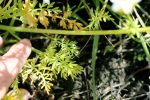 Alert hikers might first notice California hoptree (Ptelea crenulata) because of its sweet fragrance drifting across the trail. Both the leaves and the blossoms exude a sweet scent. This makes it a good garden plant not just for its own sake, but also because ants and other insects love the flowers, and in turn attract jays, flycatchers and other birds. Each blossom is very pretty, with 4 or 5 narrow white petals, and stamens tipped with bright yellow pollen. Look for ants happily roaming across the sprays of small white flowers.
Alert hikers might first notice California hoptree (Ptelea crenulata) because of its sweet fragrance drifting across the trail. Both the leaves and the blossoms exude a sweet scent. This makes it a good garden plant not just for its own sake, but also because ants and other insects love the flowers, and in turn attract jays, flycatchers and other birds. Each blossom is very pretty, with 4 or 5 narrow white petals, and stamens tipped with bright yellow pollen. Look for ants happily roaming across the sprays of small white flowers.
This California endemic grows in canyons and woodlands; the distribution loosely circles the Central Valley (as you can see on this map).
California hoptree have distinctive deep green, shiny leaves divided into three leaflets. But be careful–it can easily be mistaken for another three-leafleted native: poison oak!! Both also have small white flowers, so be sure to be cautious.















